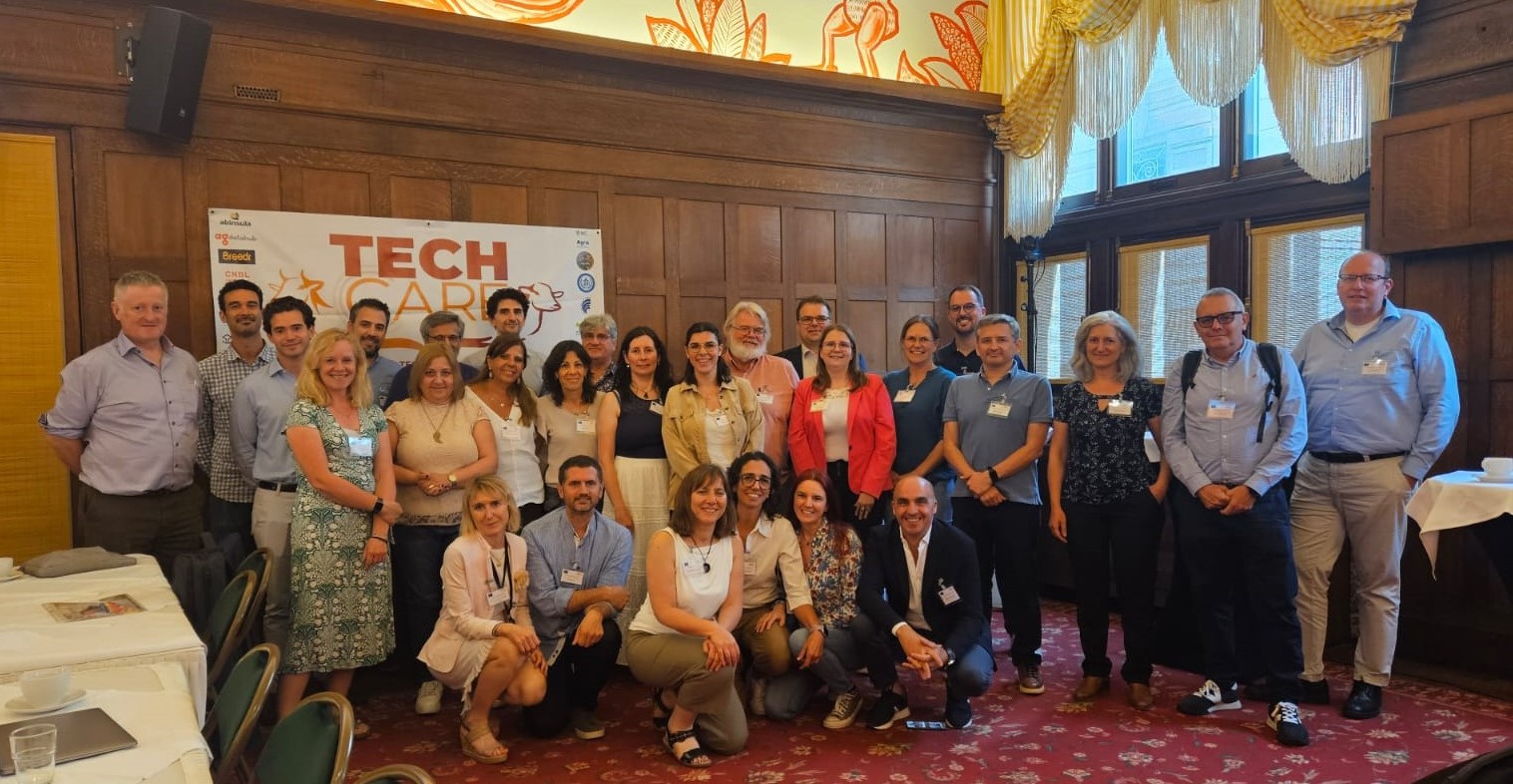– by C. Morgan-Davies (SRUC)
The final conference of the TechCare project took place in Brussels on the 17-18th June 2025. Over 86 people attended the 2 days, both online and in person from over 16 different countries. The event was a great opportunity to take stock after 5 years of exciting research across Europe on the use of innovative technologies for small ruminants welfare management, with proofs of concept, prototypes, pilot trials and large-scale studies to leverage technologies and data to identify useful early indicators for farmers in their management of the welfare of their animals both indoors & outdoors, and also during transportation.
The first day was dedicated to the project with an overview from the project coordinator, Claire Morgan-Davies (SRUC), followed by presentations from 4 other EU funded projects (DECIDE, ClearFarm, Digi4Live, aWISH) to give their experience from their project’s perspective. This was followed by presentations from Cathy Dwyer (SRUC) on the work done on welfare assessments and priorities in small ruminant systems. Germain Tesniere (IDELE), with the help of Leticia Riaguas (Oviaragon) presented the work done with the technologies tested in the pilot trials and large-scale studies, whilst Gerardo Caja (UAB) and Cathy Dwyer (SRUC) showed results of the transportation trials by road and by boat. Fiona Kenyon (MRI) then chaired the session showcasing some of the platforms developed during the project: Francesco Martini (Abinsula) showed the platform developed and calibrated with the AGRIS partners in Sardinia, to collate information and propose alerts on their pilot dairy sheep farm, whilst Gerardo Caja (UAB) presented the THIcare phone app developed in partnership with Sosein SA (Spain) using indoor sensors to alert farmers if shed conditions become an issue. Finally, Evangelia Sossidou and Sotiris Patsios (ELGO-DIMITRA) explained the participatory work carried out with the stakeholders in all partners’ countries during the project. The day concluded with a panel discussion with Ester Alaez-Pons, from DG-Santé, Cathy Dwyer, Germain Tesniere, Pol Llonch (Advisory Board member & coordinator of ClearFarm) and Michail Kakanis (Advisory Board member). They discussed issues around welfare data and alerts, and how thresholds can be identified or not. The need for meaningful alert was raised, as well as the need to identify change from ‘normal pattern’ in combination with thresholds. It was noted that the EU commissioned projects to develop more welfare indicators, as they believe that will be important going forward. Farmers’ engagement and motivation for PLF tools and welfare was also debated, as well as the need to train or at least engage further with consumers to raise awareness of welfare in sheep and goats’ systems. Finally, regarding the future of PLF tools in small ruminant systems in 10 years’ time, the ambition is to have something universally used, helping farmers in the decision-making, with technology more affordable for everyone, to improve animal welfare and help an improve standardisation of welfare standards.
The second day was dedicated to the future, with a first presentation from Victor Miguel (Oviaragon), focused on the feedback from the large-scale studies farmers who tested some of the technologies identified by the project to monitor welfare. Five promising innovations, investigated and developed during the project, were then presented, in a session chaired by Lise Grøva (NIBIO). Eliel Gonzalez-Garcia (INRAE) explained their work on the Walk over Weigh, followed by Ilan Halachmi (ARO) who showcased their system of automated weighing and water intake (TroughAI). James Wright (Breedr) showed their company application and platform, with the welfare assessment module specially developed for the project to be used by partners and translated in the project’ languages. Florian Gimbert (PageUP) then presented the application they have developed for their system using Ultra High Frequency ear-tags, and finally, Claire Morgan-Davies presented the work done at SRUC looking at Bluetooth Low Energy tags and readers for proximity to resources and ewe-lamb relationships. Presentations by Ilan Halachmi (ARO) on closing the loop between welfare intervention and technologies, and by Nuphar Katzman (Spark) on potential business models, concluded the discussions. The day finished with a panel discussion featuring Alessandro Mazette (Advisory Board member), Michael Odinstov (EAAP PLF industry representative), Francisco Pietro (Sosain SA) and Eliel Gonzalez-Garcia. The panel discussed how to go from prototypes/innovations towards a market application. Challenges to explain the worth of technological solutions in the long-term were raised, as well as the need for R&D to provide final easy-to-use versions. Data information from the technologies and sensors was found to be the greatest value for the reputation of the farming products to the market and the consumer. The need for technical support was also raised, as service, retention of the product and long-term use are important metrics. How to encourage tech companies to invest in technologies designed for small ruminant systems was another point discussed by the panel, with the difficulty to transition from university/research state to product state being raised. As volume is important for the tech business to allow investment, it would be crucial to point out the size of the small ruminant sector, as well as the other factors and services the sector potential provides (e.g. cultural, ecosystems, environmental). The need for a multidimensional approach when marketing technologies was viewed an interesting approach by the panel.
The two-days were rich in results and discussions and provided an excellent way to conclude the project’s work. Thanks to all who participated and made this event a success! Stay tuned: Replay is online here.

